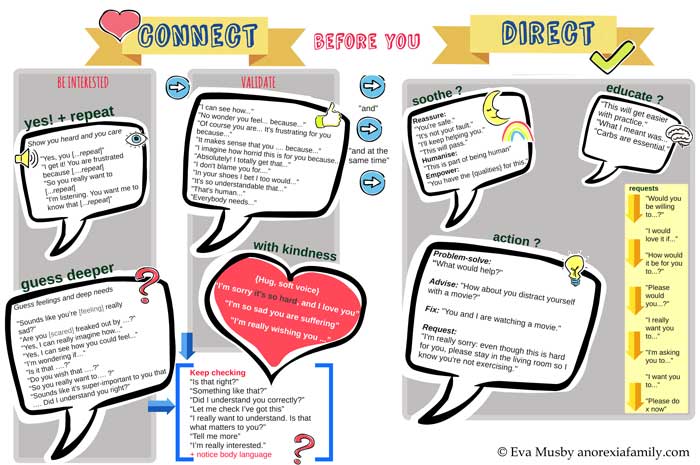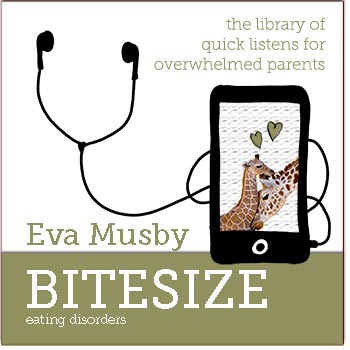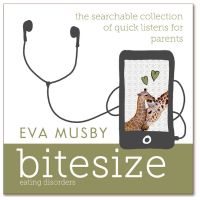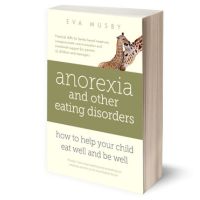Your cart is currently empty!

Powerful tools for wellbeing and compassionate connection when your son or daughter has an eating disorder
This is an excerpt from Chapter 13 of 'Anorexia and other eating disorders – how to help your child eat well and be well'
To hear me demonstrating some of what follows, check out the many Bitesize audios on this topic. I also occasionally run a workshop to help parents with communication.
A guide to compassionate communication, to help you guide your child through the toughest challenges and help them thrive. And because you need to be effective and powerful, and because you are a role-model for your child, I also show you how self-compassion works. If you are fearful about what to say, if your child’s emotions – and your own – are all over the place, this chapter will help you be the confident, courageous and resilient parent your child needs.
So far I’ve concentrated on practical aspects of the illness and its treatment. To succeed, we must also regulate our emotions and speak skillfully. We know that it’s unproductive to shout or blame or criticise. We don’t want to be so fearful; we don’t want to walk on eggshells. It’s hard to be at our best when we are anxious for our children and when they resist us with all their might.
The tools in this chapter have allowed me to start difficult conversations with my daughter, because I had the confidence that I could steer any dialogue, however emotive, all the way to resolution and reconnection. I’m going to take you through simple principles and examples, and I hope this will make things a lot easier for you.
You and your child will be closer, which will feel good. Also, you will be modelling how to manage one’s emotions, something few of us have ever been taught. Compassionate communication should make refeeding and exposure to fear foods a lot smoother. Dialogue doesn’t end when you get a ‘No’. Think ‘compassionate persistence’.
Later in this chapter I’ll also show you how self-compassion works. It will help you be more of the person you want to be, embodying compassion, trustworthiness and power. As an added benefit, you’ll be modelling an important wellbeing tool for your child.
“I managed to move on this afternoon from feeling incredibly upset and angry to a state of self-compassion and compassion towards my daughter. And she responded positively and moved on from her anger to a better place. She felt my compassion. It works!”
This chapter is about principles. I’ll help you with their application to common situations in the following two chapters. As always, use only what works for you, and tailor it to your situation. As it may be helpful to hear examples, not just read them, check out my videos and my Bitesize audio collection.
This is the best of what I’ve found in Nonviolent Communication, Emotion-Focused Family Therapy, self-compassion, CBT, DBT and related therapies.[ii] The tools here can become your everyday language not just with your child but with your other children, your spouse, friends, boss, your elderly parent, your dog. They make life richer. If compassion sounds to you like an exclusively ‘soft’ female skill, that’s not the case. Nonviolent Communication has been used to bring together men in war-torn zones, and research on mindfulness and compassion covers all genders.
‘I’m sorry, and I love you’
Our aim is to move away from pointless fights:

to connection:

In the first cartoon, we first have a parent justifying themselves (‘Yes I do understand you!’), and after that it all goes pear-shaped. Connection is built in the second cartoon, following this formula: ‘I’m sorry, and I love you’. You don’t have to use those exact words. What matters is that you are in empathy with your child for their pain. You show it through your body language, your tone of voice, and your words. Your message is, ‘I am sorry that you are suffering, and I care.’ Be sincere. It will make you feel better, and it will help bring your child back to their greater self, because major needs have been met: they’ve received unconditional acceptance, they know they’ve been heard, that they matter and that they’re loved.
‘I’m sorry, and I love you’ will help you stay away from justifying, accusing or retaliating. It will also stop you from jumping too early into reassurance, solutions or requests, which as I’ll explain soon, doesn’t work well at all.
Here are some more examples, and please tweak them to suit your style, as long as you show genuine kindness and concern.
- ‘My tummy is sore!’ I’m so sorry my darling. I love you.
- ‘I hate my life!’ Oh sweetheart, I am so sorry how hard things are for you at the moment.
- ‘My friends think I’m weird!’ I’m sorry, honey. That sounds lonely.
- ‘Dad hates me!’ Gosh, it must be tough to feel that your own dad hates you. I am so sorry.
- ‘Piss off!’ Hey, you’re really angry! That’s not like you. What’s up?
What do you say afterwards? I will come to that. First, I want to give you a tip if you are already thinking that anything you say always makes your child worse.
Silent empathy
Silent empathy is where you think, ‘I’m sorry, and I love you,’ without saying it out loud. Sometimes our children are in such a state that even the most wonderful words irritate them. Sometimes we are in such a state that we don’t trust ourselves to open our mouths! This is where silent empathy can be magic.
With silent empathy, you do nothing, you say nothing. You just stay there, thinking kind thoughts towards your child. You wonder what’s going on for them. What are they feeling? What matters to them so much? You don’t need to analyse or to be right; just let your heart be open.
Your body language says, ‘You’re OK. I’m OK. We’re safe. This is all fine. I love you.’ Give a bit of eye contact to show you care, but not so much that it might be received as overbearing. If your child allows it, offer to hold their hand, offer a hug. Touch, when welcomed, calms the nervous system.
[…etc…]
[Skipping some of the chapter]
Connect before you Direct

What we’ve done so far is connection. I recommend you focus on connection before you voice the rational, sensible stuff: seeking solutions, reassuring, giving instructions, educating. I’ll refer to all that as ‘Directing’. Here are examples of ‘Directing’ without first connecting:
- ‘My tummy is sore!’ You need the food, darling. As you keep eating, your digestive system will return to normal.
- ‘I hate my life!’ Things will get better once you’re eating regularly and enough.
- ‘My friends think I’m weird!’ No they don’t! Let’s invite them over and you’ll see how much they love you.
- ‘Dad hates me!’ Well you called him an idiot, so it’s not surprising you’re not best of pals right now. Why don’t you send him a nice message and make peace?
- ‘Piss off!’ Use polite language please. Would you tell me what’s up using polite words?
The ‘Directing’ in these examples is sensible, non-judgemental and totally appropriate. The only problem is, just now it is too sensible! Just now, your child has little or no access to reason because their emotions are high.
So what typically works better is to ‘Connect before you Direct’. You help your child feel safe and connected – and only when their emotions have decreased do you move on to the ‘Direction’ bit.
When someone is shouting, closed off, or putting up resistance, they’re in a state of fight, flight, or freeze – with little access to rational thought (remember our bungee jump?). When we use a kind voice and body language, when we show interest and non-judgement, when we make them feel cared for, their nervous system gets the message that the threat is over, and they regain access to their full intelligence.
You may like the metaphor of an elevator. The door to reason is on the ground floor. When your child has high emotion, they might be on the 10th floor! You have to get the elevator down to the ground floor to have a reasonable conversation.[i]
‘Directing’, having a reasonable conversation, guiding, problem-solving – these are very much part of our job as parents: we impart wisdom, knowledge and reassurance. We contain our kids and provide structure by giving guidance and setting limits. We just need to ‘Connect’ first. For example:
[…etc…]
[Skipping some of the chapter]
More tools to help you connect
So far I’ve given you two tools to connect compassionately to your child: silent empathy, and some form of ‘I’m sorry, and I love you’. That may be all you need. You’re now in a compassionate mindframe and you can make the rest up as you go along. As you may want more, I’ll now walk you through my diagram titled ‘Connect before you Direct’. I’ll offer examples of things to say and I encourage you to adapt them so they are natural to you. […etc…]

[Skipping some of the chapter]
Self-compassion

[End of this excerpt…]
In this chapter:
- ‘I’m sorry, and I love you’
- Silent empathy
- Connect before you Direct
- Keep tracking
- Keep checking: use question marks
- Keep your ‘but’ out of it
- Open question or empathy guess?
- More tools to help you connect
- Kindness
- Be interested: ‘Yes!’ and repeat
- Guess deeper: feelings and needs
- Be interested: feelings
- Be interested: what are the deep needs?
- Be interested: make use of the chatterbox
- Validate feelings and needs
- And now at last, ‘Direct’!
- How to express yourself effectively
- Self-compassion
- Get compassion from others too
- When to do self-compassion
- What if the feelings are overwhelming?
- Examples of self-compassion
Where to next?
* Next chapter 14: Connecting with your child *
* Jump to chapter 15 on Resilience if you'd rather build up your own emotional wellbeing right now *
On a related topic:
* My YouTube: 'Connect before you Direct' *
* In this site's search box, use tag 'self-compassion'
* My guide to self-compassion on 'Self-compassion: how to recover your inner strength' *
* Internal conflict: self-compassion and how to mediate arguments in your brain *
* Compassionate or Nonviolent Communication: what is it; find courses *
Hear examples of communication in many audios in my Bitesize audio collection, and come to my communication workshop. We can also connect one-on-one by video call:
Last updated on:
Comments
-
Hi Eva
I think I found more tips tonight on your website but I still don't get tips on how to let my teenage girl stop purgeing and bingeing. She restrict meals missing breakfast and refuse snacks until about 2pm. Then she will eat what we ate and purge the meal. She will then wait until 4:30 pm snacking on something, having dinner at 5:30 pm or 6pm and the purge that too. Thereafter she will be hungry and will want a snack even if it is an apple or 500g of dates.
She hates the cravings and that is why she refuse to start eating for as long as possible.
She also craves unhealthy stuff although we eat healthy meals 90% of the time, preparing them ourselves.
As I mentioned in my mail the psychologist said family treatment is best and also because we are in lock down in South Africa so no group therapies available. I agree with your sheets and video on re-feeding that it won't help to force her to eat. It makes her rebellious but what do I do? I negotiate her into not purging snacks and that works, but I can't get her to start with breakfast or a snack each day. And if she do have some food at 10am or 12am, she is in a state because the craving don't stop for the rest of the day.
She can't even have protein shakes. Just tissue salts and Vitamines.
I am running out of ideas. She is 15 so I can't use tricks or distractions to make her eat or to keep her after a meal from vomiting. We are desperate for help. Even professional dietitians don't want to help unless she stops purging.
Blessings
THE MOM-
Dear "The Mom", I have emailed you. You and your daughter are in a situation typical of people who don't have enough professional support. There are parents who do manage to help their child all the same, using lots of learning from resources like parents forums and books. I'm glad you have found more tips on my website and please know there is loads more in my book, which has helped others in situations similar to yours.
Love, Eva
-
-
Hi Eva
This website is the best help I have ever gotten and I have searched a lot!!
I have no idea if this letter will reach you or your reply will reach me here down under in South Africa. My daughter WAS a happy ballerina but got hurt through people's comments over time. She has always been real thin, but after a compliment she decided to stay thin and she didn't want to have a body change after she grows up and having woman's cycles. So she started purging. It got our of hand and she got bulimia and does binge eating and purging and stopped dancing and lost more wight.
It is COVID 19 now and we are on Level 4 so we are locked down in our homes. We took her to the hospital on referral by a psychiatrist to check her vitals en electrolytes etc, and all were well praise God. We don't feel hospitalization is the right way to go. We just don't know what to do anymore.
We have long talks with her and she talks about her deepest feelings but sometimes the talk-doors are just closed.Around mealtimes we all act normal but I feel anxious and she too. I know she will want more food saying she is still hungry and I will say sure have a little more to make her feel not judged. She refuses to eat with us at breakfast and lunch times (with me and my older daughter) because she hides breakfast and eat it together with lunch or dinner. I don't know if I should lock away extra food like open packets of cereal etc. If I try to restrict portions, she would cry and say she won't eat but luckily she WILL eat later on. The after meals she would help clean up the kitchen and then wait even 40min before she would go the the bathroom to purge.
Our pastor said we should say nothing and just give her love. I am giving her tissue salts and probiotics and Barley grass but she is very thin. She decided to dance for the fun now again (lockdown) and that kind of motivates her but she purged every meal and sometimes fruit too.
Should we just pray or is there a method in the madness we can follow? SHe said she would go talk to a counselor / psycohlogist but she said she won't change and will keep on purging if she wants to and that we won't stop her. She lost interest in schoolwork too. I must admit it is hard. I took her to art therapy too but she doesn't want to go again soon. Every joy lasts for a brief moment even her show dogs she wants me to sell. Thanks for hearing my long story. Blessings The Mom.
-
Dear "The Mom", no wonder you are so anxious. Your daughter is in a typical eating-disorder hole and so far you haven't found how to help her out of it. Please do read my resources (this website, my book, or use my Bitesize audios) and you will appreciate the help she needs from you and from specialised eating disorder clinicians — even if she says she doesn't want it. Keep your pastor for emotional support for you, and don't take his advice concerning eating disorders as this is not his domain.
From what you wrote (and I deleted some weight data) it seems clear to me you should NOT be restricting her portions. Your dear girl sounds very underweight, very hungry, and her 'binges' are a sign of health — her body wanting her to eat (seems to me she has anorexia, binge-purge type — not bulimia or binge-eating disorder). She needs help to eat regularly (3 meals and 3 snacks a day) that are super-nutritious so she can gain weight fast, and that will reduce her "bingeing", which in turn will help reduce the urge to purge, though she will probably need lots of support to stop the purging.
It's all in my resources, and it sounds to me like she needs professional outpatient treatment or hospital to get her onto the recovery path.
I really feel for you and hope this helps, even though it must be very confusing.
Love, Eva
-
-
This is so strange ..as I am lying in bed two hours now with music from daughters room not so loud as normal but two hours now I cant sleep I go to get a drink she hears and says what Im turning it down ..I say no its ok no problem and go back to bed then I get up again and open laptop and email and their is your letter with just the same story that is happening every night and seems like it depends on how the day went or how hungry she is many reasons …but an other time..good night
-
Thanks for that. It's great to know that this chapter works for someone who already works with NVC, and who's been on a similar journey with their daughter. I hope this chapter works for your husband. If it doesn't, do ask him to send feedback and I'll see how I can improve it.
-
I loved how you introduced NVC through the chatterbox and brought in the other components one by one, taking care to give each of them attention grounded in your own experience. To me this gives depth and authenticity that resonates deeply with my own experience and I feel grateful that you have given voice to experiences where words have often failed me. I felt particularly touched by the descriptions of 'Savouring the Need' and 'Mourning the unmet Need' as I find those the most transformative processes in my own practice.
I really wish your book had been available a year ago when I was so longing for support that embodied the values of NVC and compassion for my daughter and our family ! I have become better resourced and adept at using the NVC tools you outline and I have recommended this chapter to my husband in the hope that it may contribute to his resilience (if that's ok?).









LEAVE A COMMENT (parents, use a nickname)